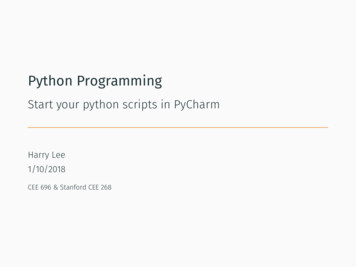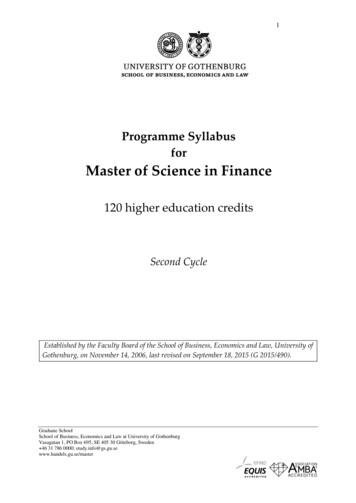
Transcription
rooman.net
Python FundamentalsMaster the fundamentals of Python.PrerequisitesAny one with a desire to learnBuilding a solid foundation to explore the fields of web development, gamedevelopment, data science & artificial intelligence. Become Industry 4.0ready with this comprehensive Python course.Who Can Attend?Web masters, Programmers,Professional SoftwareDevelopers, Big DataScientists, Analysts,Entrepreneurs, students andanyone with a passion tolearn Python will find value inattending this course.What you will getŸ 100 hours of online liveclassesŸ 200 coding assignments1. Introduction·Compilation v/s Interpretation·Script mode and Interactive mode·Command Line Arguments2. Data Types·Basic Data typesa.Numbers (int, float, complex)b.Stringsc.Bool·Advance Data types (List, tuple, set, dictionary)·Type castinga.Implicitb.Explicit3. Functions·Ÿ Dedicated mentorsŸ Talks from industry expertsTypes of Functionsa.User Defined Functionsb.Built-in Functionsc.Lambda FunctionŸ Real time projectsi.FilterŸ 100% placementii.Reduceiii.Mapassistanced.Recursive Function·Doc String·Types of Argumentsa.Positional argumentsb.Default argumentsc.Keyword argumentsd.Variable length argumentse.Variable length Keyword tals/
Python Fundamentals4. Modules in Python·Importing a Module using alias·Importing using from keyword·Input()·name () and main ()·Turtle Module·Math module5. List·Creation of lists·Accessing list elements·List slicing·List replication·Appending two list·a.append()b.extend()c.using ' ' operatorRemoving an element from a lista.pop()b.del keyword·Reference Type Assignment·Copy Operation using memory map··a.Shallow copyb.Deep copyList Comprehensiona.Using for loopb.Using list comprehensionc.List comprehension using single if conditiond.List comprehension with multiple if conditionse.List comprehension using else conditionAccessing lista.Using for loopb.Using range()c.Accessing elements present within nested list·Reversing a list·List Comparison·List als/
Python Fundamentals·a.Ascending orderb.Descending orderMembership Check of List6. Tuples··Membership Check of Lista.Creation of tupleb.Creation of singleton tuplec.Packing and Unpackingd.Unpacking using disposable variablee.Accessing elements within a tuplef.Tuple Slicingg.Copy operation in tupleList and tuple Comparison7. Set·Creation of set·Set mmetric Differencee.Subsetf.Super setg.Disjoint setSet methodsa.add()b.discard()c.remove()·Frozen set·Set Comprehensiona.Using for loopb.Using set comprehensionc.set comprehension using single if conditiond.set comprehension with multiple if conditionse.set comprehension using else condition·All and Any function·Internal Implementation of /
Python Fundamentals·List performance analysis·When to use a List.·Internal Implementation of tuple·Performance Analysis·Difference between list and tuple·Internal Implements of set·Performance analysis of set·Difference between list and set·Difference between tuple and set8. Dictionary·Internal Implementation of Dictionary·Creation of Dictionary·Adding elements to a dictionary·Accessing elements from a dictionary·Accessing values from a dictionary using get()·Different ways of deleting elements from a dictionary··a.pop()b.popitem()c.del keywordd.clear()Different ways of accessing a dictionarye.keys()f.values()g.items()Different ways of iterating over a dictionarya.keys()b.values()c.items()·Membership check in a dictionary·Merging of dictionaries·a.Using update()b.Using **Dictionary Comprehensionsa.Using for loopb.Using dictionaryc.Dictionary comprehension using single if ntals/
Python Fundamentalsd.Dictionary comprehension with multiple if conditionse.Dictionary comprehension using else condition·When to use a Dictionary·Zip()a.·Zip() function on list of varying lengthDifference between List, tuple, set and dictionary9. Collections Module·Dequeue·Named Tuple·Ordered Dictionary·Default Dictionary·Chain map·Counter10. String·Different ways of creating a string·Internal Implementation of String·String Formatting··a.Default formattingb.Positional formattingc.Keyword formattingd.Binary formattinge.% Formatting SpecifierBuilt-in functions in tswith()j.endswith()Accessing individual character of a Stringa.Forward directionb.Reverse ntals/
Python Fundamentals··String Comparisona.Using valuesb.Using Referencec.Ignoring cased.Difference between casefold() and lower()String Concatenationa.Using ' ' Operatorb.Using join()c.Using format()d.Using 'f' string literal11. Regular Expressions·Quantifiers·Word Character·Character class·Grouping·Raw String·Re Module·a.match()b.search()c.Difference between match() and ()i.group()j.compile()Flags12. Exception Handling·User Defined Exception Handler·Disadvantage of having single Except block·Grouping multiple exceptions in a single except block·Printing the default message of exception by aliasingexception object·Optional else block·Propagation of exception ls/
Python Fundamentals·Use of 'raise' keyword in exception handling·Handling the exception using try-except blocks·Re-throwing an exception·Valid and in-valid syntax of try-except block·Difference between exception handling in python and java·Customized Exception in python·Exception Hierarchy·Scope of variable in pythona.Accessing global variable within the functionb.Difference between globals() and locals() methodsc.Nested function scope in python13. Loggers·Levels of rmatters in loggers·Traceback error log file·Levels for respective file handlinga.ERRORb.INFOc.DEBUG14. File Handling in Python·Reading a file·Modes of file·Closing a file·Context Managers in python·Reading file contents line by line·Reading a single line in a file·Reading multiple lines in a file·Reading a character in a line·readline()·Cursor fundamentals/
Python Fundamentalsb.seek()·Writing a file·File modes in usive Creation·Exclusive Mode operation·File to File transfer15. Os Modules16. Object Orientation in Python·Object creation in python·Creation of instance variable in python·new ()·init ()·self keyword in python·static and non-static methods in python17. Iterators and Generators·Iteratorsa.Difference between containers and non-containersb.iter () and next ()c.Iter tools �erence between normal function and iteratorfunctionb.Use of 'yield' keyword in pythonc.Control flow diagram of iterators and generators18. First class functions19. Closures20. entals/
Python Fundamentals21. Oops �Abstraction22. Operator overloading and Magic Methods23. Multi-Threading in ls/
Python Fundamentals 19. Closures a. Difference between normal function and iterator function b. Use of 'yield' keyword in python c. Control flow diagram of iterators and generators 18. First class functions 20. Decorators · Generators · Read b. seek() · Writing a file · File modes in











